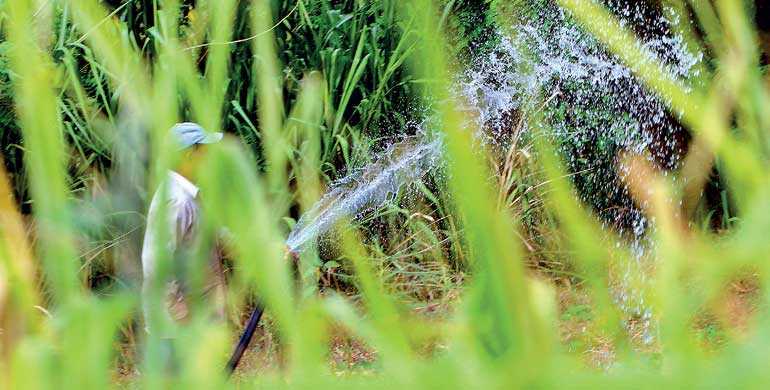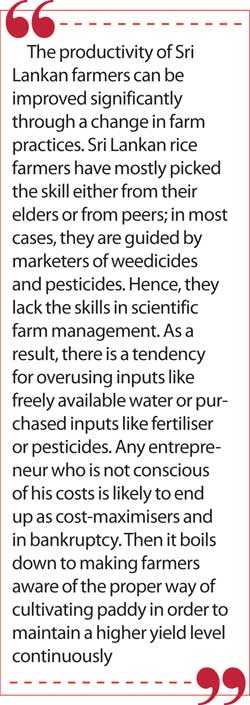Monday Apr 28, 2025
Monday Apr 28, 2025
Tuesday, 26 May 2020 00:40 - - {{hitsCtrl.values.hits}}

This is not the first time the Central Bank has spoken aloud on the need for introducing new technology to the country’s agriculture. Practically, in every annual report it has
produced in the last two decades, the bank has emphasised on the need for improving agricultural productivity through new innovative practices – Pic by Shehan Gunasekara
The Central Bank guiding on technology in agriculture
The Central Bank in its Annual Report for 2019 has published a box article on why and how Sri Lanka’s agriculture should adopt new technology (pp 60-2). This is its informed response to the popular public opinion now pretty much in vogue in the country. 
That public opinion seeks to establish that Sri Lanka is an agriculture-based country from time immemorial, it should go back to its roots and re-establish agriculture, especially the paddy farming and other food crops, as the country’s main growth driver and wealth creator. This has become the catchword after the country was locked down to prevent the spread of the COVID-19 pandemic and internal marketing system that had worked well up to that time had got virtually disrupted.
Because of the logistical problems faced by other food exporting countries, the import stream of agricultural products too had been reduced to nothing. There was panic buying of food items by almost everyone in fear of an oncoming grave food shortage. This is understandable because without foods, no one can survive.
Capitalising on these fears, the anti-trade lobby that included some mainstream economists as well got itself worked up and succeeded in penetrating the chief policy making body of the government to get its view carried by them.
Protecting agriculture
That took the form of imposing restrictions on the importation of food items in the guise of protecting the farmers, on one side, and developing a domestic agricultural sector, on the other. The buzzword was that Sri Lanka should not import anything that it could produce here locally.
Now, this has been elevated to a mass drive in which everyone is having a home garden in the backyard to make the family self-sufficient in food items and re-cultivating abandoned paddy fields in urban areas to assure food security to Sri Lankan people. These are laudable goals and no one can have objections to them. But if it is done on old lines, its ability to rescue the country as planned is limited. That may be the reason for the Central Bank to talk about the need for introducing new technology to develop the country’s agriculture on modern lines.
Central Bank has cautioned the Government in the past too
However, this is not the first time the Central Bank has spoken aloud on the need for introducing new technology to the country’s agriculture. Practically, in every annual report it has produced in the last two decades, the bank has emphasised on the need for improving agricultural productivity through new innovative practices.
For instance, the Annual Report for 2000, while recognising the need for protecting farmers, had warned the government that it should not be done through high import duties or their ad hoc changes. Pursuing such a policy would result only in hiding the inefficiency in the sector and burdening the consumers.
Instead, a consistent and predictable policy environment had been suggested by the bank. Such a system, while generating an efficient resource allocation, would encourage all those who are involved in the long supply chain in agriculture to come up with a long-term sustainable agricultural development strategy. This supply chain includes, according to the Central Bank, not only the farmers but also all the input suppliers, lenders, traders, stockholders, millers, and finally industrialists who would use agri-products as industry inputs (p 36).
What the Central Bank had implied had been that removal of any of these key players would result in permanently damaging the agri-ecology of the country. And that is what we have done in the past by demonising, especially, input suppliers or paddy millers through malicious propaganda. And those propaganda have forced them to spend time and use their money to defend themselves rather than for coming up with suitable strategies.
Low productivity in agriculture
The box article in the latest Annual Report has tried to tackle the problem of low productivity in agriculture through the adoption of innovative technologies.
Sri Lanka had been an active player of the Green Revolution in 1960s that was successful in pushing the agricultural output to high levels to meet the rising demand for same by ever rising mouths in the world. The new practices involving high-yielding varieties, chemical fertiliser and pesticides and expanded irrigation systems had transformed the country’s agriculture significantly.
Fourth Industrial Revolution and agriculture
However, a worrying factor has been the virtual stagnation of the agricultural productivity in the country in the past few years, says the Box Article. To overcome this, it has suggested that Sri Lanka should go for ‘smart farming’ in which limited resources are used in the most efficient and effective manner to produce the maximum output possible.
Smart farming sits well with the new technologies that are being introduced in the new Fourth Industrial Revolution or 4IR that the world is going through right now. Sri Lanka which is still in the initial stage of the Second Industrial Revolution or 2IR should make a ‘leap-frog’ exercise over the Third Industrial Revolution or 3IR to 4IR which had been advocated by the Institute of Policy Studies in its State of the Economy Report for 2019 released some six months ago. I have reviewed it in a previous article in this series available at http://www.ft.lk/columns/Presidential-aspirants-and-voters-Read-IPS-s-SOE-2019-before-you-make-your-next-move/4-688892.

When inputs are in short supply, use them efficiently and effectively
In my view, this box article should be read by everyone who has agriculture and its future close to his heart. The article has documented all the new developments that are presently taking place in the sector, what they have in store for all the stakeholders in the sector, how Sri Lanka should move forward in developing a sustainable agricultural sector. It is much more than having home gardens and re-cultivating abandoned paddy fields, albeit they are also useful to create public awareness. But they cannot offer a potential growth driver and wealth creator to Sri Lanka.
What is needed is to adopt systems that would use the limited resources efficiently, that is, using the least to produce the most, and effectively, that is, what is being used would deliver precisely what they were expected to do. This is the foundation of smart farming in a world in which inputs are in short supply and should be used with care and caution.
Paddy farmers are over-users of inputs
Sri Lanka’s paddy farmers are known for overusing water, fertiliser and pesticides. I have commented on this in a previous article in this series and branded rice as a water-guzzler (available at: http://www.ft.lk/columns/Resolving-the-paradox-of-rice-poverty-amidst-plenty/4-658623).
According to the Manila-based International Rice Research Institute, the practice of complete flooding of paddy fields to rid them of weeds has caused the use of some 2,500 litres of water to produce just one kg of rice. Out of that, the actual amount which the rice plant use is only 1,432 litres and the balance 1,000 odd litres are wasted.
Since water is not available aplenty, pretty soon the world will drive itself to the wall: no more water is available and therefore no more rice for filling those increasing number of mouths. Similarly, fertiliser is used excessively or without reference to the need of the rice plant at the particular stage of its development.
Apply inputs according to the needs of the plant
At present, water, fertiliser and herbicides are managed generally at macro level according to the general needs of the rice plant. However, at micro level, these have to be done by reference to the specific needs of the plant when it is producing tillers or initiating panicles.
This can be done just by looking at the field but by measuring and assessing the needs of the rice plant. To do so, sensors are being used by modern farmers to release the exact amount of water and the correct type of fertiliser. This is not a complex technology that can be used only by farmers in developed countries. Sensor technology is in common use today and therefore can easily be accessed by farmers in emerging economies as well.
If the farmers could minimise the use of inputs and use them by reference to the need of the plant, its effectivity is to increase yields and consequently their incomes as well. This is the effective protection that can be given to farmers who are being harassed by vicissitudes of markets, weather and adverse Government policies.
A weed chipper that does not use herbicides
Since there is a growing global concern about the use of herbicides in agriculture, scientists have been focussing on herbicide-free weeding methods. In this connection, agricultural engineers at the University of Western Australia together with those at the University of Sydney have invented a weed-chipper that uses sensors to detect weeds and remove them from the fields without damaging the plant or the upper soil of the field.
It uses commercially available sensor-fitted arms similar to tines in a fork to scrape the weeds and then bury in the field to provide additional organic fertiliser to the plant. A Western Australia based manufacturing company is to produce and supply these weed-chippers to the market soon (available at: http://www.news.uwa.edu.au/2020022411870/australian-farmers-reap-rewards-weed-chipper).
This is a breakthrough technology and once its benefits are known by farmers and consumers, it is inevitable that it would soon catch-up in a world now wary of hazardous health effects of the use of herbicides in agriculture.
Developing drought resistant paddies
Scientists in IRRI and in leading universities are now engaged in developing water-efficient paddy cultivation methods. IRRI has come up with an ‘alternative wetting and drying’ method. In this method, a field is flooded for a few days and after that water is used up, kept it dry for a few more days before it is flooded again. This method is to save about 30% of water normally used in paddy farming without affecting the rice yield.
Another method suggested is sprinkling water to the field producing ‘aerobic rice’ just like watering a leafy vegetable field. This would save water up to 50%, but there would be a reduction in the output by about 30% (available at: http://irri.org/blogs/bas-bouman-s-blog-global-rice-science-partnership/does-rice-really-use-too-much-water).
Hence, it is useful in cultivating paddy in relatively water-scarce regions. But scientists in the University of Western Australia or UWA have attempted at developing a new rice variety which is drought resistant so that it could alleviate drought stress (available at: https://research-repository.uwa.edu.au/en/publications/advances-in-drought-resistance-of-rice ). This is the best method of cultivating rice in arid places like Hambantota or Mannar districts in Sri Lanka.
Improve farm practices
The productivity of Sri Lankan farmers can be improved significantly through a change in farm practices. Sri Lankan rice farmers have mostly picked the skill either from their elders or from peers; in most cases, they are guided by marketers of weedicides and pesticides. Hence, they lack the skills in scientific farm management.
As a result, there is a tendency for overusing inputs like freely available water or purchased inputs like fertiliser or pesticides. Any entrepreneur who is not conscious of his costs is likely to end up as cost-maximisers and in bankruptcy. Then it boils down to making farmers aware of the proper way of cultivating paddy in order to maintain a higher yield level continuously.
Rice as an industrial input
Rice is now used increasingly as an industrial raw material in other parts of the world. Rice straw which is presently wasted or burned down in fields is a good raw material for paper manufacturing; it is estimated that every kilogram of rice also produces 1-1.5 kg of straw which is a high harvest. Paper manufacturing using rice straw pulp can be started as a cottage industry by imparting the needed technical knowhow to villagers.
Rice can be used as malt for producing wine, whiskey and beer. This will open a good export market for Sri Lanka rice which cannot be exported as a food due to the shortness of the grain. Rice bran can be converted to rice bran oil, an alternative edible oil. Rice milk, like soy milk, is a substitute milk for those who have lacto intolerance.
Proteins isolated from rice can be presented as supplementary protein capsules like the fish oil capsules available in the market today. Rice can also be used for producing perfumes, a natural variety that will have a good attraction.
Hence, taking initiatives to develop Sri Lanka’s agriculture is a laudable goal. But it should be done not on old lines but on modern lines. In this context, the box article published by the Central Bank in its Annual Report is an eye-opener for all.
(The writer, a former Deputy Governor of the Central Bank of Sri Lanka, can be reached at [email protected])
Discover Kapruka, the leading online shopping platform in Sri Lanka, where you can conveniently send Gifts and Flowers to your loved ones for any event including Valentine ’s Day. Explore a wide range of popular Shopping Categories on Kapruka, including Toys, Groceries, Electronics, Birthday Cakes, Fruits, Chocolates, Flower Bouquets, Clothing, Watches, Lingerie, Gift Sets and Jewellery. Also if you’re interested in selling with Kapruka, Partner Central by Kapruka is the best solution to start with. Moreover, through Kapruka Global Shop, you can also enjoy the convenience of purchasing products from renowned platforms like Amazon and eBay and have them delivered to Sri Lanka.
Discover Kapruka, the leading online shopping platform in Sri Lanka, where you can conveniently send Gifts and Flowers to your loved ones for any event including Valentine ’s Day. Explore a wide range of popular Shopping Categories on Kapruka, including Toys, Groceries, Electronics, Birthday Cakes, Fruits, Chocolates, Flower Bouquets, Clothing, Watches, Lingerie, Gift Sets and Jewellery. Also if you’re interested in selling with Kapruka, Partner Central by Kapruka is the best solution to start with. Moreover, through Kapruka Global Shop, you can also enjoy the convenience of purchasing products from renowned platforms like Amazon and eBay and have them delivered to Sri Lanka.